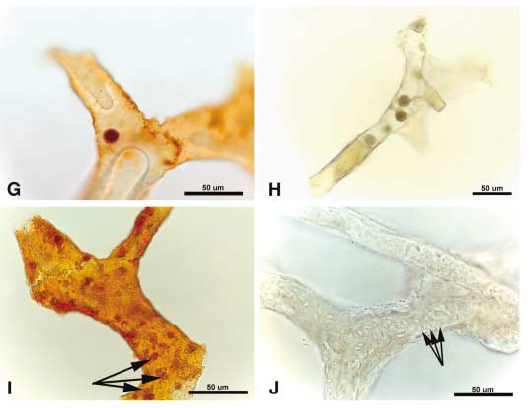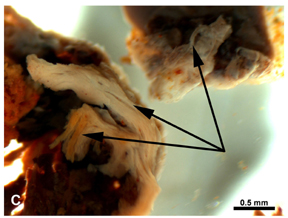Geotimes

Untitled Document

Web Extra
Friday, March 25, 2005 updated
March 28
Broken bones yield T. rex
tissue
 It
may have seemed like an unlucky break at the time, but when researchers had
to slice a Tyrannosaurus rex femur in half to get it out of the field,
they found something completely unexpected. After some initial cleaning, paleobiologist
Mary Schweitzer at North Carolina State University in Raleigh and her co-workers
found that the T. rex bone still contained what looks like the original
structure of blood vessels and other soft tissues. This is the first time that
such tissues have been found so well-preserved.
It
may have seemed like an unlucky break at the time, but when researchers had
to slice a Tyrannosaurus rex femur in half to get it out of the field,
they found something completely unexpected. After some initial cleaning, paleobiologist
Mary Schweitzer at North Carolina State University in Raleigh and her co-workers
found that the T. rex bone still contained what looks like the original
structure of blood vessels and other soft tissues. This is the first time that
such tissues have been found so well-preserved.
After finding a T. rex specimen at a remote field site in the Hell Creek
Formation in Wyoming, members of a field team led by Jack Horner of the Museum
of the Rockies at Montana State University in Bozeman encased it for removal
by helicopter. But the piece was too heavy and had to be cut in two. Back in
the lab, scientists recognized what they had and set the pieces of bone containing
what looked like soft tissues aside for Schweitzer, who worked with Horner's
team before moving to North Carolina last year.
A newly published study compares T.
rex blood vessels to those of an ostrich, one of the most primitive birds
and most likely related to dinosaurs. Mary Schweitzer and her co-workers isolated
a fragment of a T. rex dinosaur blood vessel (G) that seems to retain
its original microstructures; they compared it to a vessel (H) removed from
an ostrich bone that still contains red blood cells, which has similar branching
structure. The T. rex vessel fragment (I) here shows cell nuclei (arrows)
in the vessel wall, with detail of the branching pattern that looks similar
to such nuclei and branching in an ostrich blood vessel (J). Courtesy of Science.
"No preservative ever touched them," says Schweitzer, who took the
bone samples to her laboratory in North Carolina and performed as many analyses
on it as she could, including demineralizing the bone with weak acid to get
to the preserved tissues inside and examining the pieces under a scanning electron
microscope. "We had a three-week run where we just didn't sleep."
Their analyses compared the structures to blood vessels in ostriches, which
look stunningly similar (see images). "Ostriches are the most primitive
of living birds, and probably have more in common with dinosaurs than with robins,"
Schweitzer says. For now, she says she needs more equipment to look more carefully
at the structures before anything can be said for certain about what they are
composed of.
Images published in the March 25 issue of Science show tiny "dots"
that could have been blood cells, or some other structure, among other interesting
visible characteristics. The tissues also remain surprisingly flexible. "They
sure look like cells and soft tissue matrix," Schweitzer says. "It's
hard to imagine mineral replication that is flexible and still transparent."
"There's a subtle gradation in the way you can preserve fossils,"
says Matt Carrano, curator of Dinosauria at the Smithsonian National Museum
of Natural History. Typically, minerals completely replace all the "original"
materials or structures in a dead animal, in order to create a fossil, retaining
only the shape; even soft tissue preservation tends to be limited to skin impressions
or other such secondary forms.
The team's discovery of such well-preserved tissues "is a big deal in
that respect, and it's pretty uncommon to have this kind of preservation in
fossils at all," Carrano says. He also notes that in dinosaurs, past research
by Schweitzer and others has found that some original materials, such as the
original keratin in dinosaur claws, have the potential to survive unchanged.
(Other paleobiologists consider these findings somewhat controversial, however.)
 Carrano
says that most of the remains are fossilized, making it a very strong physical
structure. "It's an ideal situation," he says. "You've got almost
a sealed outer shell," protecting the "naturally occurring spaces
in the bone. Those spaces are largely not open to the environment," and
anything that would degrade the original components could have been blocked
out. "In my personal opinion, I would not be surprised if they find original
material in there," he says, though only very small amounts.
Carrano
says that most of the remains are fossilized, making it a very strong physical
structure. "It's an ideal situation," he says. "You've got almost
a sealed outer shell," protecting the "naturally occurring spaces
in the bone. Those spaces are largely not open to the environment," and
anything that would degrade the original components could have been blocked
out. "In my personal opinion, I would not be surprised if they find original
material in there," he says, though only very small amounts.
The arrows here point to regions of the
demineralized T. rex bone that look fibrous. Courtesy of Science.
The astonishing findings also have fueled discussion on whether DNA fragments
or even protein may have survived intact during their 70-million-year entombment.
The possibility has raised references to Jurassic Park in the press, but
for now, it is pure speculation as to whether such microstructures remain intact
in the T. rex fossil. "Nobody thinks this is possible, including me,"
Schweitzer says, and "we have to be extra, extra careful about it,"
when determining whether the structures are original or not.
If they exist in the sample, DNA fragments or proteins could give amazingly
detailed information on the genetic code of T. rex or details of their
metabolism, and the possible answer to the warm-blooded/cold-blooded debate.
Derek Briggs, a paleobiologist at Yale University and an expert on fossilization,
says that most likely the team will find "not much more than traces of
protein, if indeed they've even got protein," and that no DNA could survive
that long. Routine archaeological investigations can analyze DNA up to about
100,000 years old, but before that time break, other work has shown it to be
"so fragmented it's totally worthless."
Briggs says that the preservation itself is "extraordinary" and "undoubtedly
a very spectacular discovery." The "rigorous" comparative work
the team reports in supplementary material supporting the Science publication
shows that other fossils may contain similarly preserved soft tissues. Still,
how the tissues were saved remains unknown.
Briggs and others have shown that the molecules of the original material itself,
such as carapaces of beetles trapped in amber, might "recombine to form
what we could loosely call polymers," he says, that are more stable, less
likely to be broken down, and still form flexible chains of carbons. It is possible
that the molecules inside the T. rex's bone "survived long enough to
start that process," which is "astonishing," Briggs says.
"There is little doubt this kind of preservation may be far more widely
spread," he says, and if it happens in a variety of settings in different
bones, scientists could "potentially add soft tissue information to the
range of characters" they use to sort out how organisms are related. Scientists
connect different dinosaurs, for example, by their hard structures only. But
"more simply," he says, such preservation "may tell us something
about [an organism's] physiology" — the very basics of how a body works.
Naomi Lubick
Back to top
Untitled Document

 It
may have seemed like an unlucky break at the time, but when researchers had
to slice a Tyrannosaurus rex femur in half to get it out of the field,
they found something completely unexpected. After some initial cleaning, paleobiologist
Mary Schweitzer at North Carolina State University in Raleigh and her co-workers
found that the T. rex bone still contained what looks like the original
structure of blood vessels and other soft tissues. This is the first time that
such tissues have been found so well-preserved.
It
may have seemed like an unlucky break at the time, but when researchers had
to slice a Tyrannosaurus rex femur in half to get it out of the field,
they found something completely unexpected. After some initial cleaning, paleobiologist
Mary Schweitzer at North Carolina State University in Raleigh and her co-workers
found that the T. rex bone still contained what looks like the original
structure of blood vessels and other soft tissues. This is the first time that
such tissues have been found so well-preserved.
 Carrano
says that most of the remains are fossilized, making it a very strong physical
structure. "It's an ideal situation," he says. "You've got almost
a sealed outer shell," protecting the "naturally occurring spaces
in the bone. Those spaces are largely not open to the environment," and
anything that would degrade the original components could have been blocked
out. "In my personal opinion, I would not be surprised if they find original
material in there," he says, though only very small amounts.
Carrano
says that most of the remains are fossilized, making it a very strong physical
structure. "It's an ideal situation," he says. "You've got almost
a sealed outer shell," protecting the "naturally occurring spaces
in the bone. Those spaces are largely not open to the environment," and
anything that would degrade the original components could have been blocked
out. "In my personal opinion, I would not be surprised if they find original
material in there," he says, though only very small amounts.